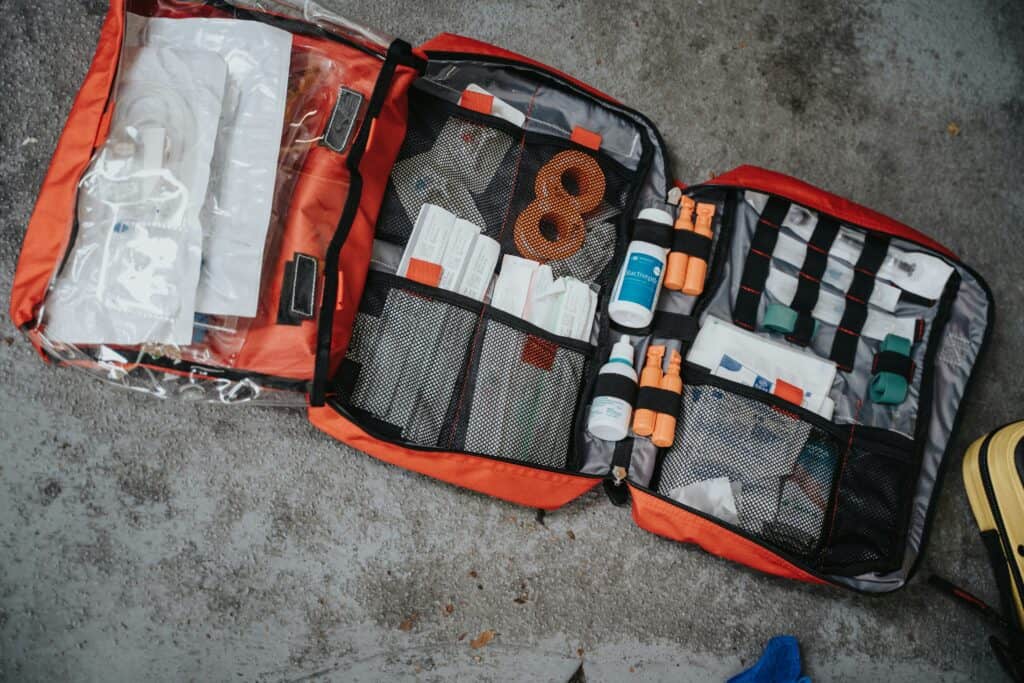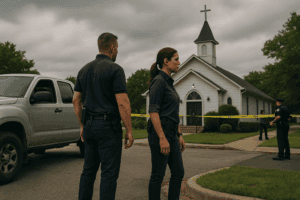Securing a church’s inner perimeter is crucial to ensure the safety and well-being of its congregants. This area generally consists of the church’s main building, including prayer rooms, administrative offices, and other common areas. Since a significant number of people often gather within this inner perimeter, it is important to have effective security measures and protocols in place to deal with potential threats.
One essential aspect of inner perimeter security is having a well-trained and knowledgeable safety team. Team members should have clearly defined roles and responsibilities, and congregation members should be familiar with basic security training and emergency procedures. In the event of a crisis, such as an active assailant scenario or emergency evacuation, both safety team members and the congregation must be prepared to respond appropriately. It is also important to consider the distinct security measures required for any school or daycare facilities associated with the church.
Implementing security features within the sanctuary, the central area of worship is vital. This area should be the focus of the security planning process, and incident management and emergency action plans should take into account the potential vulnerabilities present within the sanctuary. Reception areas and visitor management systems are also essential components of inner perimeter security, enabling rapid identification of suspicious activities and helping to control the flow of people entering and exiting the church premises.
Church Security Plan
A well-developed church security plan is essential to ensure the safety of the congregation and the protection of valuable assets. This plan should outline specific policies and procedures tailored to the needs of the facility and the people who use it. By adopting a confident, knowledgeable, neutral, and clear tone, the security plan will provide guidance on maintaining a secure environment for all.
The first step in creating a church security plan is to conduct a comprehensive assessment of the facility and its surroundings to identify potential vulnerabilities. This evaluation should focus on the inner perimeter, where the congregation gathers and is most susceptible to threats such as active shooters or unauthorized access. Additionally, the assessment should include not only the main worship area but also other structures, such as schools, rectories, or residences that may be present on the premises.
The security plan should define the roles and responsibilities of the Safety Team, who will be responsible for implementing the policies and procedures. These individuals should be knowledgeable about the church’s layout and the various threats that could endanger the congregation. In addition, they should receive regular training to stay up-to-date on the latest security practices and protocols.
Emergency procedures and evacuation plans are crucial components of any church security plan, as they ensure that the congregation knows how to respond in the event of an incident. This information should be communicated to all churchgoers, including specific instructions for different scenarios, such as an active shooter situation or a natural disaster. The CISA Active Shooter Preparedness Program provides valuable resources for developing these plans.
Reception and visitor management are other essential aspects of a church security plan. Implementing a system to monitor individuals entering the facility can help identify suspicious activity and control the flow of people throughout the building. Encouraging the congregation to be aware of their surroundings, engage with newcomers, and report any concerns to the Safety Team can further promote a secure environment.
In conclusion, a comprehensive church security plan is a vital aspect of maintaining a safe worship space for all. Through careful assessment, thorough policies and procedures, and ongoing training for the Safety Team and congregation, churches can minimize potential risks and protect their most valuable assets: their people.
Inner Perimeter Strategies
To ensure the protection of a church’s most valuable assets, such as its congregation and the multiple structures within its premises, implementing inner perimeter strategies is crucial. These strategies should prioritize attention to detail and emphasize the roles and responsibilities of the safety team.
It is essential to provide members of the church with basic security training, including protocols for emergency evacuations and active assailant scenarios. The training provided should equip individuals to recognize and respond to security threats that may arise.
An effective security plan should also include access control systems to ensure that only authorized personnel have access to restricted areas. This includes employing card readers, biometric scanners, or key codes to keep sensitive areas, like prayer rooms or administrative offices, secure.
Physical security should not be overlooked in inner perimeter strategies. This encompasses aspects such as locking doors and windows, ensuring proper illumination at night, and monitoring with surveillance cameras. Furthermore, receptive involvement in visitor management helps identify any suspicious activity, allowing for better control over possible security threats.
Incorporating these elements, inner perimeter strategies can comprise protection, emphasizing incident management and emergency action plans, as well as active shooter preparedness programs. By establishing a comprehensive security system that covers training, access control systems, and physical security measures, it is possible to significantly reduce the risk to a church’s congregation and infrastructure.
Security Team Roles and Responsibilities
The security team plays a crucial role in maintaining the safety and well-being of the church congregation and its facilities. One of the primary responsibilities of the team is overseeing the inner perimeter, which includes the main areas where people gather, such as the sanctuary, administrative offices, and other common spaces.
To ensure effective security, team members must always be vigilant and prepared. This can be achieved by clearly defining their roles and responsibilities and regularly conducting background checks on potential team members. This helps to maintain a professional security team that prioritizes the safety of the congregation.
The security team should be knowledgeable about various possible threats and emergency scenarios and be trained in emergency response procedures. This includes active shooter preparedness and understanding protocols for emergency evacuations. Conducting regular training sessions with the team members reinforces their skills, allowing them to respond efficiently in times of crisis.
Additionally, the security team should collaborate closely with the church staff and congregation members, promoting awareness of basic security measures and training programs to ensure a unified approach to maintaining safety. This may include educating churchgoers about recognizing and reporting suspicious activities, as well as providing guidance on how to react during emergency situations.
In summary, the security team is an essential component of the inner perimeter safety strategy. By defining clear roles and responsibilities, conducting background checks, carrying out regular training, and collaborating with the church community, they effectively protect the congregation and church facilities from potential threats.
Sanctuary Safety Measures
The sanctuary is the main area of worship and often has the largest congregation of people, making it a crucial focus for security planning. Implementing sanctuary safety measures will ensure the protection of the congregation and provide a secure environment for worship.
Firstly, it is essential to have an emergency action plan in place to respond swiftly and effectively to threatening situations. This plan should be clearly communicated to all congregation members and outline specific evacuation routes, shelter-in-place procedures, and designated roles for various safety team members.
Developing appropriate tactics for sanctuary protection involves constant vigilance and a comprehensive understanding of potential risks. Integrating security systems, such as surveillance cameras, alarms, and access control measures, will further enhance the safety of the sanctuary. Regular safety audits and risk assessments should be conducted to identify vulnerabilities and monitor the effectiveness of implemented security measures.
Training the congregation to identify suspicious activity and report any concerns is vital in maintaining a secure environment. Implementing a visitor management system can help recognize potential threats and ensure that all individuals entering the sanctuary are positively identified. The “Power of Hello” approach can also assist in identifying suspicious activity by engaging in conversation with visitors to gauge their intentions.
Finally, having an active shooter preparedness program in place can help guide the congregation on how to respond in the event of an armed assailant. This program includes regular drills, safety briefings, and guidance on specific actions to take during this type of emergency.
By implementing these sanctuary safety measures, congregations can confidently and safely carry out their worship practices in a secure environment.
Reception and Visitor Management
Reception and visitor management play a crucial role in church security, particularly within the inner perimeter. Implementing effective procedures for managing visitors can help maintain a safe environment for the congregation and staff. Ushers and greeters should be trained in identifying suspicious activity and following protocols to address any potential security concerns.
A well-trained team of ushers can serve as the first line of defense in a house of worship. They are responsible for welcoming visitors, guiding them to their seats, and ensuring a smooth flow of people during services. Ushers should be familiar with emergency procedures and trained to react accordingly in the event of an incident.
Visitor management protocols can help control the flow of people entering the church and identify any suspicious individuals. Effective communication among ushers, greeters, and other church staff is imperative to ensure that potential threats are noticed and addressed promptly. This communication can be supported by tools such as church-specific visitor management software, which can aid in tracking and monitoring visitors.
In addition to ushers and greeters, congregation members can also be trained to identify suspicious activity, enhancing the overall security within the inner perimeter. The power of a simple “hello” to visitors can serve as a deterrent to those with malicious intentions, as they may realize that they are being noticed and monitored.
Training sessions on emergency procedures, CISA Active Shooter Preparedness, and ways to spot suspicious activity should be held regularly for both staff and congregation members. This ensures that everyone is knowledgeable and prepared to respond during an emergency situation. Offering information on these topics can also help cultivate a culture of security awareness within the house of worship.
By implementing effective reception and visitor management strategies, church security teams can better protect their congregation, staff, and facilities, ensuring a safe and welcoming environment for all who attend.
Medical Emergency Preparedness
Preparing for medical emergencies at a church or house of worship is crucial to ensure the safety and well-being of the congregation. This involves having a well-established protocol, trained individuals, and readily available equipment in case of emergencies.
One vital aspect of medical emergency preparedness is having an Automated External Defibrillator (AED) on-site. An AED is a portable, life-saving device designed to treat sudden cardiac arrests by delivering an electric shock to the heart, restoring its normal rhythm. Churches should consider installing an AED and providing regular training to designated staff members and volunteers on its usage.
In addition to having an AED, it is essential to form a designated Medical Team. This team should consist of individuals with basic first aid and CPR training, preparing them to respond to various medical emergencies. Churches can collaborate with local organizations or certified trainers to provide this training to their staff and volunteers.
Communication is key during medical emergencies. The Medical Team should be easily identifiable, with specific roles and responsibilities assigned to each member. Additionally, there should be an established method for alerting first responders in the event of an emergency, which may include calling 911 or using a designated emergency notification system.
Furthermore, it is crucial to have a well-stocked first aid kit on hand. This kit should contain essential medical supplies, such as adhesive bandages, gauze, antiseptic wipes, and disposable gloves. Ensure that the first aid kit is in an easily accessible location and that all members of the First Aid Team are aware of its location.
Finally, regular drills should be conducted to assess the effectiveness of the medical emergency plan and identify areas for improvement. This practice will not only help solidify the protocol but also increase the confidence and preparedness of church staff and volunteers in handling medical emergencies.
By implementing these strategies, churches can create a safer environment for their congregations, fostering confidence in their ability to respond effectively to medical emergencies.
Fire and Emergency Evacuation Plans
Proper fire and emergency evacuation plans are crucial for ensuring the safety of churchgoers and staff during a sudden or unexpected event. These plans should be well-documented, easily accessible to all members, and regularly reviewed and updated as needed.
It is important to prioritize the identification of potential fire hazards, such as electrical issues, improperly stored flammable materials, or blocked fire exits. Regular maintenance and inspections can help to minimize the risk of fires and other emergencies. Additionally, installing fire alarms, smoke detectors, and adequate fire extinguishing equipment can greatly enhance the safety of the inner perimeter.
Emergency evacuation plans should include clear, easy-to-follow procedures for people to safely exit the building during various emergency situations. These plans should be developed in collaboration with local fire departments, law enforcement, and facility management to ensure a cohesive approach. Providing training and guidance to congregation members and staff on critical elements such as emergency communication, exit routes, and designated meeting points is essential for successful emergency evacuations.
In times of crisis, such as fires, accidents, or other emergencies, having well-trained church staff or volunteers can significantly improve the overall response and management of the situation. This can include first aid training, crowd management skills, and knowledge of when and how to contact emergency services.
While schools and daycare facilities within the church premises may have specific safety and security considerations, it’s crucial to include them in the overall fire and emergency evacuation planning process. This ensures that all individuals are knowledgeable about the steps to take during an emergency, resulting in greater safety and security for everyone within the facility.
By implementing and maintaining clear, comprehensive fire and emergency evacuation plans, churches can effectively protect their congregation members, staff, and visitors, allowing them to feel confident and secure in their spiritual communities.
Parking Lot Security

Parking lot security is critical to the overall safety of a church, as it is often the first point of entry for congregation members and visitors. A well-secured parking lot can not only deter potential security threats but also provide peace of mind to those attending services or events at the church.
One effective strategy to improve parking lot security is having designated safety team members or volunteers patrolling the area. They should be equipped with two-way radios to maintain constant communication with other team members, as well as the church staff in case of emergencies. This allows for quick responses to any potential threats or suspicious activities.
In addition to patrolling personnel, the installation of security cameras in strategic locations throughout the parking lot can act as a deterrent to potential criminals. Well-lit parking areas can also contribute to increased safety, as they discourage potential attackers by making it difficult for them to conceal their activities.
The parking lot should also have clear signage indicating the entrance and exit points, as well as the designated areas for handicapped or emergency vehicle parking. This helps to guide the flow of traffic and enables a more orderly evacuation in case of any emergencies.
Furthermore, it is advisable to conduct regular security assessments of the parking lot to identify vulnerabilities and continuously improve safety measures. By being proactive in addressing potential security threats, churches can create a safer and more inviting environment for their congregants and visitors.
Managing Financial Security
Managing financial security is a critical aspect for houses of worship, ensuring that donations, tithes, and other monetary contributions are kept safe and used responsibly. Implementing proper financial controls and protocols can help prevent theft, fraud, and other risks associated with handling cash.
One effective method for managing financial security is to establish a formal system for tracking and handling cash donations. This may include the use of secure containers or locked bags, as well as designated individuals responsible for counting and depositing funds. It is important to maintain a thorough record of all transactions and to regularly review these records to identify and address any discrepancies.
In addition to physical cash handling procedures, secure electronic accounting systems can be employed to monitor the flow of funds and maintain accurate records. These systems should be password protected and accessible only to authorized individuals. Regular backups of financial data should be conducted to ensure information is not lost due to system failures or cyberattacks.
Financial transparency is another key component of financial security. Making financial information accessible to congregation members and other stakeholders promotes trust and accountability. This may include producing annual financial reports and making them available to the public.
Implementing a system of checks and balances can further enhance financial security. This may involve assigning different tasks and responsibilities to multiple individuals, ensuring that no single person has complete control over the organization’s finances. For example, the person responsible for counting cash should not be the same individual depositing it into the bank.
Financial security should also take into account the security of physical assets, such as valuable religious artifacts or items used during worship services. These items should be stored securely when not in use and monitored to prevent theft or damage.
Overall, managing financial security is an essential aspect of maintaining a safe and secure environment for houses of worship. Implementing robust financial protocols and practices can help protect the organization’s assets and ensure that contributions are used responsibly and transparently.
Collaboration with Law Enforcement
Collaborating with law enforcement is a crucial aspect of maintaining a secure inner perimeter for your church or house of worship (HoW). Establishing partnerships and open communication channels helps keep everyone informed, promotes a coordinated response in the event of an incident, and fosters a safer environment.
Churches and HoWs should develop clear protocols for contacting law enforcement and reporting suspicious behavior or emergencies. This can be achieved through regular meetings, joint training programs, and sharing security best practices. Encouraging congregants to attend relevant training programs offered by local law enforcement can ensure they are prepared to respond appropriately in emergencies.
Utilize the expertise of law enforcement by inviting them to assess your HoW’s security vulnerabilities and provide recommendations for improvement. Police officers, for example, may detect areas of concern that have not yet been identified and can assist with the development of crime prevention plans.
Creating a security liaison relationship with local law enforcement representatives is valuable for maintaining a strong line of communication. This liaison can serve as a direct contact for coordinating security plans, updates, and alerts, helping to build trust between your HoW and the responding agencies.
Churches and HoWs should also coordinate with law enforcement during major events or large gatherings. Having a visible police presence can deter potential offenders and provide an added layer of security for attendees. Additionally, working together on crowd control strategies will contribute to the overall safety of the event.
In conclusion, effective collaboration with law enforcement enhances the safety of your church or HoW by providing a unified and efficient response to potential threats. Establishing solid partnerships, implementing effective reporting protocols, and integrating law enforcement resources will ultimately strengthen your inner perimeter security.
Community Outreach and Awareness
Community outreach and awareness play a significant role in enhancing the security of houses of worship. Engaging with the local community can build strong relationships and establish a supportive network that addresses the unique concerns and threats faced by different religious organizations. It is crucial for houses of worship to collaborate with local law enforcement, first responders, and other community stakeholders to ensure adequate emergency preparedness and efficient response to potential incidents.
One approach to increasing community awareness and cooperation is through the organization of community events. These events can be in the form of educational workshops, seminars, or even open house gatherings where community members can learn about the importance of safety and security in houses of worship. By providing an opportunity for conversation and information sharing, houses of worship can increase engagement and support from the community.
Another vital aspect of community outreach is the development of partnerships with other religious organizations and houses of worship in the area. By working together, sharing information, and providing mutual support, these institutions can consolidate their efforts in addressing security concerns and developing effective security protocols.
Implementing comprehensive security training programs for the congregation is crucial in maintaining a safe environment within the inner perimeter of houses of worship. Members should be educated on emergency procedures, with resources like CISA’s Active Shooter Preparedness program serving as helpful tools in this regard.
In conclusion, effective community outreach and awareness initiatives contribute to the overall security and well-being of both houses of worship and the surrounding community. By fostering relationships, sharing knowledge, and working together, religious organizations can create a safer environment for their congregations and maintain open lines of communication within the larger community.
Frequently Asked Questions
What are the crucial components of an effective inner perimeter strategy?
An effective inner perimeter strategy should focus on sanctuary protection, clearly defined roles for the safety team, proper access control measures, visitor management, preparing for emergency evacuation or active assailant scenarios, and establishing safe rooms or shelter-in-place areas.
How can a safety team’s roles and responsibilities be clearly defined?
To define the roles and responsibilities of a safety team, ensure that each member is trained in emergency procedures, aware of their specific duties, and understands the proper communication channels during an incident. Consistent training and drills can further reinforce these responsibilities.
What are recommended access control measures for a house of worship?
Recommended access control measures for a house of worship may include secure locks on doors and windows, monitoring systems such as CCTV cameras and alarm systems, the use of identification badges for staff, and clear protocols for granting or denying entry to specific areas.
Why is visitor management crucial for inner perimeter security?
Visitor management is essential for inner perimeter security because it enables rapid identification of suspicious activity, helps control the flow of people moving through the premises, and maintains proper communication channels in the event of an emergency.
How can a church prepare for emergency evacuation or active assailant scenarios?
Churches can prepare for emergency evacuations or active assailant scenarios by creating a comprehensive emergency action plan that covers evacuation routes, assembly points, communicating with emergency responders, and regularly conducting drills to familiarize congregants with established procedures.
What are essential considerations when establishing safe rooms or shelter-in-place areas?
When establishing safe rooms or shelter-in-place areas, consider factors such as the location, construction, and security features of the space to ensure it can provide adequate protection in the event of emergencies. Ensure that the area is easily accessible, contains necessary supplies such as first aid kits, flashlights, and communication devices, and is designed to accommodate the congregation’s size and specific needs.








